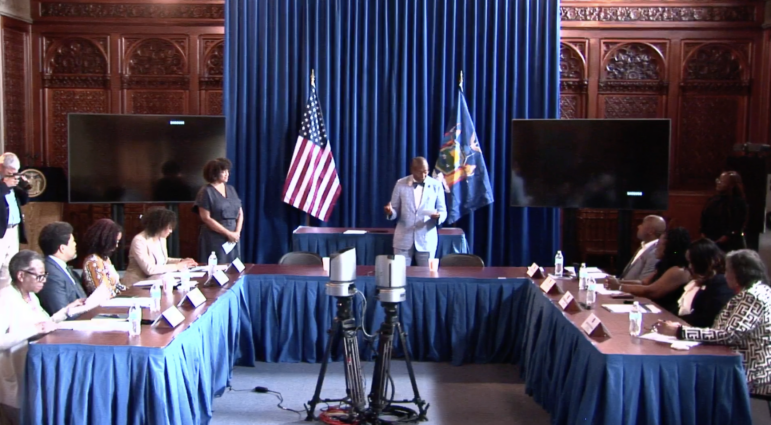The commission will have 12 months from the date of its first meeting to issue a report with recommended actions to provide reparations to Black New Yorkers, to address the long-standing effects of the legacy of slavery. New York is one of nearly two dozen cities and states that have introduced legislation to take on such efforts.

Governor’s Office/Flickr
Gov. Kathy Hochul and local leaders in late 2023, signing the legislation to establish the reparations task force.
The New York Reparations Commission met for the first time on July 30, a few months after Gov. Kathy Hochul formally announced its creation.
With eight of its nine members present, the committee unanimously selected a chairperson, Dr. Seanelle Hawkins, who currently serves as president of the Urban League of Rochester and has an extensive career in nonprofit leadership. The committee was unable to settle on a vice chair, so the matter was adjourned for a subsequent meeting to be held within 30 days.
During an interview with City Limits, commission member Jennifer Jones-Austin explained that the group had to implement “the coordinating structure” for their work before officially meeting.
Their task is time-sensitive: the commission will have 12 months from the date of its first meeting to issue a report with recommended actions to provide reparations to Black New Yorkers, to address the long-standing effects of the legacy of slavery.
Trevor Smith, a young organizer with New Yorkers for Reparations, is at the forefront of the grassroots effort to build public support for reparations and for New York State’s Commission itself.
“When the recommendations come out, legislators still have to write bills and get those bills signed, based on the recommendations,” Smith said. “And so there has to be an advocacy apparatus that is pushing legislators to actually turn these recommendations into legislation.”
Jones-Austin did not specify what the recommendations from the commission could entail, but indicated that they would consider the results of similar initiatives in other cities.
“It’s only when the work is done and we develop a sense of how extensive the harms are and how the harms manifest, can we make recommendations for the actual reparations that could result,” she said.
Across the nation, 22 localities have approved a reparations commission or task force, and 11 states have introduced legislation to create one, including the first task force formed in California, and a currently embattled housing reparations program in Evanston, Illinois.
Evanston’s program is a response to the city’s history of anti-Black housing policies, providing $25,000 to qualifying applicants. Recipients can use the funds in various ways, including mortgage assistance, for renovations, the downpayment for a home or a direct cash disbursement. The program has been lauded as an effective way to combat the impact of the wealth gap that results from racial inequities, though it’s also faced a lawsuit filed by a conservative group.
New York State has a higher racial wealth gap than the national average; its white population has nearly 15 times more wealth than their Black counterparts. The median household net worth for white New Yorkers is $276,900, dwarfing that of Black New Yorkers, which stands at $18,870, according to a report from the city comptroller’s office.
“The racial wealth gap is the best single economic indicator of the cumulative intergenerational effects of white supremacy,” said Dr. William Darity, economist and scholar at the Sanford School of Public Policy, who studies inequality by race and class.
However, Darity believes that reparations efforts enacted by individual states will be “incomplete,” since states do not have enough resources to meet the scope of what is due.
His research puts a substantive overall figure to the concept of reparations owed to Black Americans—$16 trillion—which he says should be paid by the federal government. The figure is derived from the roughly $800,000 difference in household wealth between Black and white Americans, according to the 2019 federal census survey.
“I think people perceive in particular localities and states that they can get something adopted that they can put under the label of reparations—it’s low hanging fruit,” Darity told City Limits. “And so they pursue that rather than engaging in the much harder struggle of transforming Congress, getting different elected officials, so that Congress will take the actions necessary.”
New York’s Commission on Reparations, though still in its early stages, has gained more momentum than similar efforts at the federal level. A bill commonly known as “H.R. 40” envisions a reparations commission to study the effects of slavery on a national scale, with an accompanying list of solutions. It was first brought before Congress in 1989 by Rep. John Conyers, and has yet to gain enough support to pass.
The fact that New York has managed to not only establish its own commission, but host its first meeting, represents a significant step. However, a clear path to implementation of these policies is not guaranteed, if the status of previous measures are any indication.

Screenshot/Anastasia Tomkins
A livestream of the state’s Reparations Commission during its first meeting July 30.
Racial justice reforms approved by New York City voters back in 2022 have experienced a delayed rollout, as reported by Gothamist. The reforms were intended to make racial equality an integral part of the city’s decision-making processes, according to the Racial Justice Commission that drafted them.
They included plans to renovate “cost of living” metrics and to set racial equity goals across city agencies every two years. The deadlines for launching these deliverables were missed, and then extended. A preliminary “Citywide Racial Equity Plan,” is expected this fall, according to a revamped timeline published on the website of the Mayor’s Office of Equity and Racial Justice, which was established to carry out the reforms.
The topic of reparations as one aspect of racial justice reform can be controversial, often divided along racial lines. A 2021 Pew Research survey found that 77 percent of Black Americans support reparations for descendants of enslaved people, while only 18 percent of white Americans say the same.
“None of us were alive during the era of mass institutional slavery, but the effects of those evils do, in fact, continue to today. We see that in the wealth gap, we see that in other forms,” said Pastor Duke Kwon, co-author of the book, “Reparations: A Christian Call for Repentance and Repair.”
“The effect of that original sin endures to today, so does the calling and moral mandate for us to make repair of those original sins,” he said.
While the battle for reparations trudges on, the gap between the haves and have nots is widening in New York. Young adult New Yorkers between the ages of 18-30 are more likely than other groups to experience poverty, with people of color being disproportionately affected. And a recent report by the Community Service Society (a City Limits funder) finds that as many as a quarter of New Yorkers with student loan debt face severe economic hardship. Again, the research highlights significant disparities by race.
By all estimates, it is virtually impossible for Black citizens to save or invest enough to attain white levels of financial security without the redistribution of resources. Nevertheless, legal challenges to racial equity-related initiatives are increasingly common.
“This is a time for us, in terms of the civil rights movement, for people who have been directly impacted and our allies to continue to push forward,” said Lanessa Owens-Chaplin, director of the NYCLU’s Racial Justice Center. “We have to continue to fight for reparations. I think it’s now more important than ever to keep that momentum going and to keep striving for what is owed.”
To reach the reporter behind this story, contact Anastasia@citylimits.org. To reach the editor, contact Jeanmarie@citylimits.org
Want to republish this story? Find City Limits’ reprint policy here.





